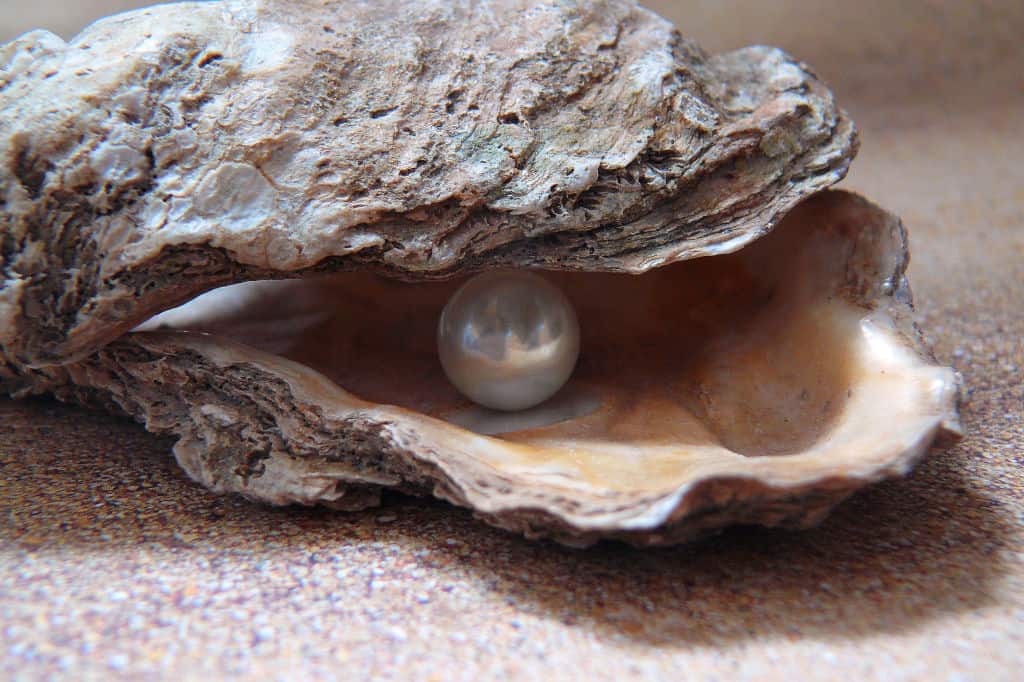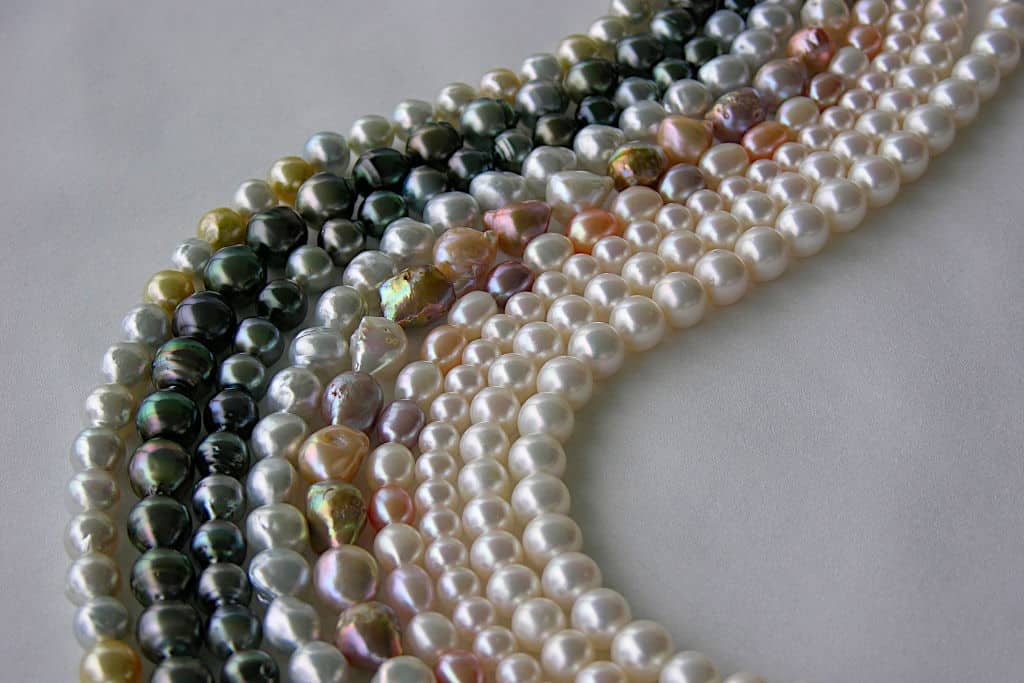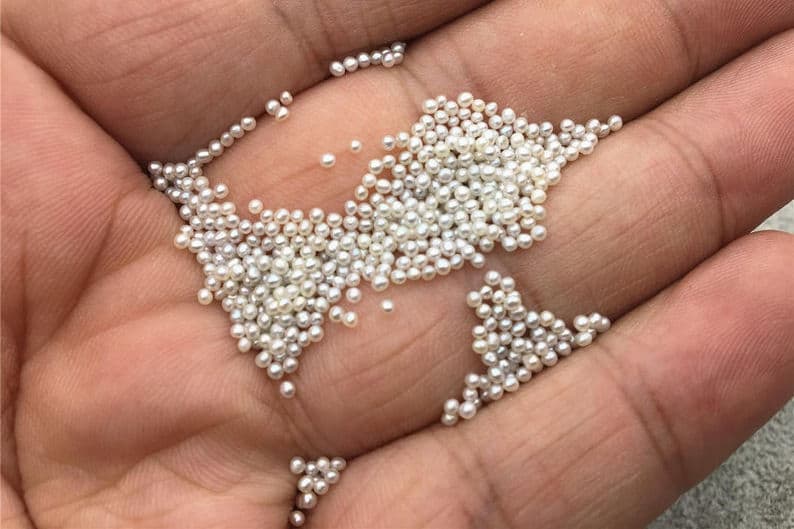Are you diving to find your own pearls? Or simply interested in growing them yourself? I was wondering the same things, so I took the time to research all about how pearls form, and how you can actually grow your own pearls.
How Long Does It Take for a Pearl to Form? It takes at least 6 months for a pearl to form. However, pearls are typically left for at least a year to grow to a decent size.
Pearls can be harvested as early as 6 months in, but the longer the pearls are cultivated, the greater the chances of harvesting a large, high-quality pearl. Freshwater pearls are usually cultivated for 18-24 months before harvesting.
Freshwater pearl takes less time to develop because the layers of nacre (which is what forms a pearl) are not as compact as those surrounding saltwater pearls. But, they can grow just as big.
Do All Oysters Have Pearls?
Any oyster, clam, or mussel has the potential to form a pearl naturally, though some are more common in some species than others.
They all have a mollusk, which creates a material of a pearl. Larger oysters may have a slightly higher chance to have pearls in them, as they are older and had more time to create a pearl.

Unfortunately, there is no obvious sign to know if a pearl is inside an oyster, mussel, or clam – you’ll have to open it to see.
If you’re thinking of going diving and trying to find your own oyster with a pearl in it, then keep reading. The odds of you finding a pearl are very rare.
How Rare is It to Find a Pearl in an Oyster?
Natural pearls are very rare to find. In fact, only 1 in 10,000 wild oysters will have a pearl, let alone the jewelry-graded ones.
Most pearls that you see in the world are cultured pearls, created by farming, like this Akoya cultured pearl necklace.
Natural pearls, created without human intervention, are extremely rare to find. Today, pearls are cultured in pearl farms, and it takes usually a few years before a pearl is created.
How Are Pearls Made by Oysters and Clams?
Pearls, nature’s precious gemstones, can form naturally inside oysters, mussels, or clams.
The formation begins when an irritant, often a parasite, enters the mollusk. Contrary to popular belief, grains of sand are rarely, if ever, the cause of pearl formation.
To protect itself, the mollusk coats the irritant with nacre, layer by layer. Over time, this results in the creation of a shimmering pearl. The growth rate of nacre varies: For Akoya pearls, it’s around 0.3mm per year; for Tahitian and Australian South Sea pearls, it’s about 2mm per year; and Chinese freshwater pearls can grow up to 5mm per year.
Environmental Factors in Pearl Formation
Pearl cultivation is an intricate dance with nature. While the process can be initiated by humans, the environment in which the mollusk resides plays a pivotal role in determining the quality and beauty of the resulting pearl.
Clear waters, devoid of pollutants, not only enhance the pearl’s luster but also reduce chances of external blemishes. Factors such as water temperature, salinity, and even the availability of food for the oysters can influence the nacre’s deposition rate.
For instance, in colder waters, the nacre layers may be denser, leading to pearls with deeper luster. On the other hand, warmer waters could result in quicker deposition but might compromise on the nacre’s thickness. Monitoring these environmental variables is paramount for pearl farmers to ensure optimal pearl growth.
Cultured Pearls: A Deeper Dive
The process of cultivating pearls involves farmers carefully introducing a nucleus, often a piece of mantle tissue or “Mother of Pearl” bead, into an oyster. This deliberate intervention mirrors the natural process.
- Implantation: Farming starts with the introduction of the nucleus, often sourced from a freshwater mussel.
- Nacre Formation: In just 1-3 months, nacre begins forming around the nucleus, with its layers determining the pearl’s ultimate luster.
- Growth Factors: Pearls’ size and beauty depend on several variables like the type of mollusk, water temperature, and cleanliness. For example, Akoya pearls can grow to 9mm in 10-14 months, Tahitian pearls might achieve 10mm in 18-24 months, while South Sea pearls can reach a whopping 15mm in 2-3 years.
Sustainability in Pearl Harvesting
Pearl farming places a premium on the well-being of the oysters. Harvesting pearls doesn’t harm the mollusk. Such care ensures the sustainable and ethical production of these cherished gemstones.
Both freshwater and saltwater pearls can manifest in a spectrum of shapes and colors, from the conventional round and white to the unique and vibrantly colored, adding to their allure and value in jewelry.
How Long to Form Cultured Pearl?
Pearls are usually harvested after one year for Akoya pearl, 2–4 years for Tahitian and South Sea, and 2–7 years for Edison freshwater pearl.
Pearls grow at different rates, depending on the type of pears and a few other factors. Akoya pearl will grow up to 9mm in 10 to 14 months in diameter, a Tahitian pearl could grow 10mm in 18 to 24 months, while a South Sea pearl could reach 15mm in diameter in 2 to 3 years.
The longer you leave the clam to grow the pearl, the larger and of better quality, it will be.

If left for years to create a pearl, both freshwater and saltwater mussels can create pearls of great quality that will last you for years to come (even 50+ years). Quickly cultured pearls are lower quality because they have a too think coat of nacre, and they will wear out more quickly.
It’s interesting to note that not all pearls are created equal. Top jewelry makers create only 5-10% of pearls that are of excellent quality, but pearl farmers cultivate pearls of various quality and manage to sell them.
China is currently the world’s largest producer of freshwater pearls, producing more than 1,500 metric tons per year.
The Harvesting Conundrum: Timing is Everything
Harvesting pearls is more art than science. While there are general timelines, the exact moment of harvesting is a crucial decision.
Early harvesting might yield pearls with less nacre, compromising their longevity. However, wait too long, and the pearl could become overly large, losing its desired shape or even outgrowing the mollusk’s shell. It’s a balance of size, quality, and market demand.
Experienced pearl farmers develop an intuitive sense, often based on the mollusk’s health, water conditions, and even the pearl’s visible portion. They understand that the real magic isn’t just about growing the pearl but knowing the precise moment to bring it into the world.
How Much Are Pearls Worth?
Typically, round freshwater pearl strands range from $50 to $2000, such as this beautiful pearl necklace. A strand of Akoya pearls cost from $300 to $10,000. Akoya pearls are the smallest types of cultured pearls on the market.

For cultured pearls, we can distinguish 6 quality factors:
- Nacre – the thicker and smoother, the more valuable
- Luster – the more reflection the pearl has the more valuable
- Surface – cleaner surface is more valuable
- Shape – round and even pearls are the most valuable
- Color – depends on the popularity and taste for the region
How much pearls are worth also depends on:
- Wild vs Cultured pearl – Wild pearls are more prized
- Freshwater vs Saltwater pearl – Saltwater pearls are a bit more valuable
Seed pearls are also one of the more expensive ones.

Seed pearl is a small natural pearl, formed in either freshwater mussel or saltwater oyster, and it’s usually less than 2mm in diameter. Most of them today are created accidentally, and are very hard to prepare in a strand or jewelry piece.
Are Freshwater and Saltwater Pearls Worth the Same?
Generally speaking, they are not worth the same.
Saltwater pearls cost more than freshwater pearls, because they are many times more difficult to produce, and can only produce 1 or 2 pearls at a time. On the other claw, freshwater mussels grow up to 32 pearls per shell.
There you have it, all the important info about how long do pearls form.
This was fun to write.
Hopefully you learned something cool today. Check out my other cool posts!






![How Much Do Shipping Containers Cost? [Full Guide] Shipping Container retail shop (cost)](https://howmonk.com/wp-content/uploads/2020/03/Shipping-Container-retail-shop-300x200.jpg)





